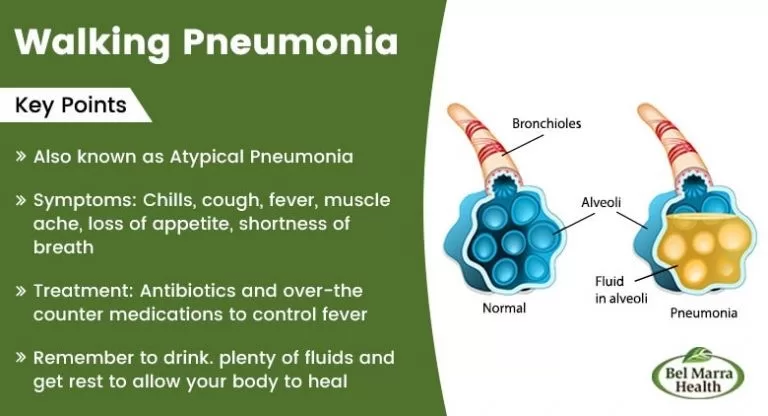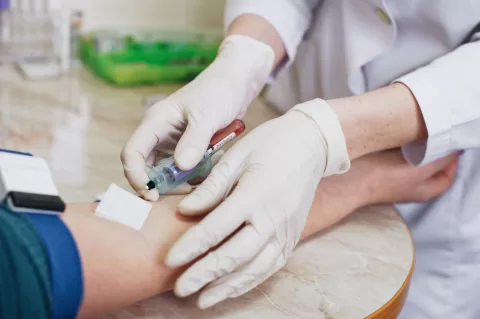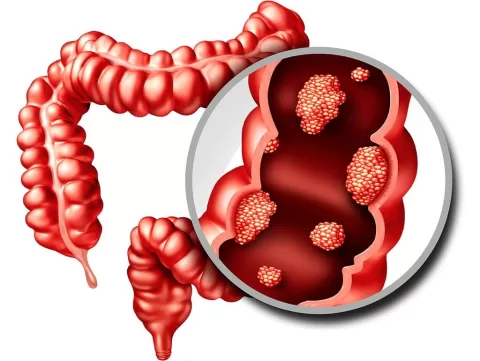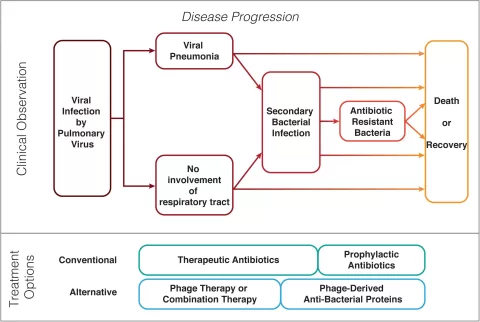Walking pneumonia is a contagious lung infection that is becoming increasingly concerning, particularly for families with young children during this year’s respiratory season. This condition, which often presents with walking pneumonia symptoms that start gradually, can mislead parents into thinking their child merely has a common cold. However, the impact of walking pneumonia can be more significant, especially among toddlers who seem to be the most affected this year. Effective walking pneumonia treatment is crucial to alleviate symptoms like prolonged fever and body aches, which indicate a more serious illness than initially perceived. As Dr. Donald Dumford, an infectious disease specialist, highlights, this type of pneumonia is particularly transmissible, necessitating heightened awareness and proactive health measures to combat the spread among vulnerable groups.
Also known as atypical pneumonia, walking pneumonia is characterized by mild but persistent respiratory symptoms that can easily go unnoticed. This respiratory illness, often triggered by a mycoplasma infection, typically circulates in cycles, impacting school-aged children and teens significantly. However, recent trends have shown that toddlers are now experiencing higher rates of infection, prompting concerns among health professionals and parents alike. Understanding the nuances between common colds and walking pneumonia is vital, as the latter may require specific treatment to manage its symptoms effectively. As respiratory illnesses surge this season, being informed about this peculiar pneumonia is essential for timely intervention.
Understanding Walking Pneumonia
Walking pneumonia is a type of bronchial infection caused primarily by the Mycoplasma pneumoniae bacteria. It is often characterized as a milder form of pneumonia, and while symptoms can be similar to those of a common cold, they may develop more slowly. Individuals with walking pneumonia usually experience symptoms over a few days, starting with respiratory issues like a dry cough or a low-grade fever. This gradual onset can lead parents to mistakenly believe their child has a minor cold when, in fact, they may be suffering from a contagious lung infection.
The majority of cases occur among school-aged children and teenagers, but the current trend indicates an alarming rise in cases among younger populations, particularly toddlers. This shift highlights not just the cyclical nature of mycoplasma infections but also the impact of recent health-related disruptions due to the pandemic, making young children more susceptible to such respiratory illnesses. Understanding the unique presentation of walking pneumonia can aid parents in seeking timely treatment and managing the disease effectively.
Identifying Symptoms of Walking Pneumonia
Recognizing walking pneumonia symptoms is crucial for timely intervention. Unlike traditional pneumonia, which can manifest suddenly with severe symptoms, walking pneumonia usually begins with mild respiratory symptoms that progressively worsen. Common signs include persistent cough, sporadic fever, and possible headaches or body aches. Children suffering from walking pneumonia may also exhibit a general sense of fatigue and malaise. It is important for parents to observe these symptoms closely, especially if they persist beyond a few days.
Differentiating between common cold symptoms and those indicative of walking pneumonia can be challenging. While a cold typically produces mild symptoms such as a runny nose and occasional cough, walking pneumonia is associated with more pronounced symptoms that affect the child’s daily functioning. Prolonged fever, significant body aches, and a noticeable drop in energy levels warrant medical evaluation to confirm the diagnosis and initiate appropriate treatment, such as antibiotics targeting the mycoplasma infection.
Walking Pneumonia Treatment Options
Treating walking pneumonia often involves antibiotic therapy, particularly for bacterial infections caused by mycoplasma. Healthcare professionals typically consider the patient’s age, symptom severity, and medical history before prescribing treatment. In most cases, children respond well to antibiotics, which help eliminate the infection and alleviate symptoms. Along with medication, rest and hydration are key components of recovery, allowing the body’s immune system to effectively fight off the infection.
In addition to medical treatment, parents can manage symptoms at home with supportive care measures. This includes ensuring the child stays hydrated and comfortable, as well as monitoring fever with appropriate medications. Additionally, maintaining good hygiene practices, such as regular hand washing and encouraging the child to cover their mouth when coughing, can help prevent the spread of walking pneumonia to other family members and classmates, effectively controlling outbreaks in community settings.
Preventive Measures Against Contagious Lung Infections
Preventing the spread of walking pneumonia and other contagious lung infections begins with common-sense health practices. Hand hygiene is paramount; children should be encouraged to wash their hands frequently, particularly after being in public places or after being in close contact with others who may be unwell. Covering coughs and sneezes with a tissue or elbow can also significantly decrease the risk of respiratory illness transmission.
Additionally, maintaining a clean and well-ventilated environment is essential in protecting children from respiratory infections. Parents should ensure that their home and school environments are regularly cleaned and disinfected, especially during peak cold and flu seasons. Awareness and education about respiratory illness prevention can empower both parents and children to take proactive steps, minimizing the risk of encountering numerous infections, including walking pneumonia.
Understanding Respiratory Illness in Children
Respiratory illnesses in children can encompass a wide range of conditions, from mild colds to more serious infections like pneumonia. Parents should be vigilant about their child’s respiratory health, as young children, particularly toddlers, are still developing their immune systems and can be more susceptible to infections. Monitoring symptoms closely allows for a quicker response to potential health issues.
It’s also important for parents to stay informed about the common respiratory illnesses circulating in their communities, including walking pneumonia. Awareness of symptoms and transmission can help them better protect their children and recognize when medical intervention is necessary. Resources such as health care professionals and the CDC can provide valuable information and guidance on minimizing the risk of respiratory illnesses among young children.
The Role of Mycoplasma in Walking Pneumonia
Mycoplasma pneumoniae is the primary bacterial agent responsible for walking pneumonia, and it plays a crucial role in the transmission of the disease. Unlike other pathogens, mycoplasma bacteria lack a cell wall, which allows them to evade some common antibiotics. Understanding the biological characteristics of mycoplasma is essential for developing effective treatment strategies and public health responses to contain outbreaks.
While mycoplasma infections can rise cyclically, the recent decline in respiratory illnesses during the pandemic has left many children vulnerable. Increased awareness about mycoplasma infections can assist parents and healthcare providers in recognizing and addressing outbreaks, particularly in school settings where children are in close contact. Continuous education on the signs and symptoms associated with mycoplasma pneumonia can ultimately foster a proactive approach toward prevention and care.
The Importance of Medical Attention for Walking Pneumonia
Timely medical intervention for walking pneumonia is critical for ensuring proper recovery and minimizing potential complications. Parents should not hesitate to reach out to healthcare providers if their child exhibits prolonged fever, troubling respiratory symptoms, or significant discomfort. Early diagnosis can lead to quicker relief through the appropriate antibiotic treatments, often resolving symptoms more effectively and swiftly.
Furthermore, consulting with medical professionals can provide parents with valuable insights and recommendations for managing walking pneumonia. Specialists like infectious disease experts can offer guidance on monitoring the child’s condition, understanding the nature and course of the illness, and discussing preventive measures for other family members. Having open lines of communication with healthcare providers empowers parents to make informed decisions about their child’s health.
Addressing Misconceptions about Walking Pneumonia
There are several misconceptions about walking pneumonia that can lead to confusion among parents. One common myth is that walking pneumonia is a less serious condition that doesn’t require medical attention. In reality, while it may be milder than other types of pneumonia, it still necessitates proper evaluation and, in many cases, treatment with antibiotics to prevent further complications and to minimize time lost from school or other activities.
Another misconception is that walking pneumonia is exclusively a problem for older children and adolescents. Recent trends highlight that younger children, especially toddlers, are increasingly affected by this contagious lung infection. Educational outreach to parents can help clarify these misconceptions, equipping them with accurate information to recognize symptoms and understand the importance of timely medical care.
Long-term Implications of Walking Pneumonia
While walking pneumonia is often perceived as a mild illness, its implications can extend beyond the immediate symptoms. Children who experience walking pneumonia may suffer from longer-lasting fatigue or respiratory issues, which could impact their daily activities, including school performance and social interactions. Understanding these potential long-term effects is crucial for parents to effectively support their child’s recovery process.
In addition to physical well-being, addressing the emotional aspects of dealing with any illness, including walking pneumonia, is essential. Parents should monitor their child’s emotional state and provide necessary support and encouragement as they recover. Empowering children with knowledge about their illness can help them better understand what they are experiencing, reducing anxiety and fostering resilience.
Frequently Asked Questions
What is walking pneumonia and how does it differ from regular pneumonia?
Walking pneumonia is a contagious lung infection primarily caused by mycoplasma bacteria. Unlike regular pneumonia, which typically presents with severe symptoms requiring hospitalization, walking pneumonia often causes milder symptoms such as a slow-developing cough and low-grade fever. It mostly affects school-aged children and teenagers, but there’s been a notable increase in cases among toddlers this year.
What are the common walking pneumonia symptoms to watch for in children?
Symptoms of walking pneumonia include a persistent dry cough, fever, headaches, body aches, and fatigue. In children, these symptoms can appear gradually over several days, often resembling a severe cold or flu. If your child displays prolonged fever or severe discomfort, it’s crucial to seek medical attention.
Is walking pneumonia contagious, and how does it spread?
Yes, walking pneumonia is highly contagious, spreading through respiratory droplets when an infected person coughs or sneezes. Studies show that about 80% of siblings in a family may contract the illness if one child is infected. Practicing good hygiene, like hand washing and covering coughs, can reduce the spread of this respiratory illness.
What walking pneumonia treatment options are available?
Treatment for walking pneumonia usually involves antibiotics, as it is caused by a bacterial infection. It’s important to consult a healthcare provider for an accurate diagnosis and appropriate treatment plan. Over-the-counter medications may also help alleviate symptoms like cough and fever.
How can parents prevent walking pneumonia in toddlers and children?
To prevent walking pneumonia and other respiratory illnesses, parents should promote good hygiene practices, such as frequent hand washing, encouraging children to cover their mouths while coughing, and maintaining clean environments. Keeping kids away from sick peers can also help minimize the risk of contracting infections.
What should parents know about the rise of walking pneumonia cases in children?
There has been a significant increase in walking pneumonia cases among children, especially toddlers, this year. The cyclical nature of the mycoplasma infection, combined with reduced immunity following the COVID pandemic, has left many kids vulnerable. Parents should be vigilant about recognizing symptoms and understanding when to seek medical help.
| Key Point | Details |
|---|---|
| Rise in Cases | There is an alarming increase in walking pneumonia cases across the U.S., particularly affecting young children this year. |
| Affected Age Groups | While typically impacting school-aged children and teenagers, this year toddlers are facing the greatest impact. |
| Symptoms | Walking pneumonia often features milder symptoms than classic pneumonia, beginning with a cough or fever and may lead to headaches and body aches. |
| Contagious Nature | Walking pneumonia is highly contagious; up to 80% of siblings in families may get infected if one child has it. |
| Prevention | Practices such as hand washing and covering coughs are critical in reducing the spread of walking pneumonia and other respiratory diseases. |
| Medical Attention | Parents should recognize significant symptoms like prolonged fever and body aches, which may indicate the need for antibiotics. |
Summary
Walking pneumonia is increasingly becoming a significant concern for parents, particularly this year as it disproportionately affects toddlers. Understanding its symptoms, contagion rates, and preventive measures is crucial in safeguarding children’s health. With walking pneumonia showing cyclical trends in surges, awareness and proper health practices can help mitigate its impact.
The content provided on this blog (e.g., symptom descriptions, health tips, or general advice) is for informational purposes only and is not a substitute for professional medical advice, diagnosis, or treatment. Always seek the guidance of your physician or other qualified healthcare provider with any questions you may have regarding a medical condition. Never disregard professional medical advice or delay seeking it because of something you have read on this website. If you believe you may have a medical emergency, call your doctor or emergency services immediately. Reliance on any information provided by this blog is solely at your own risk.








